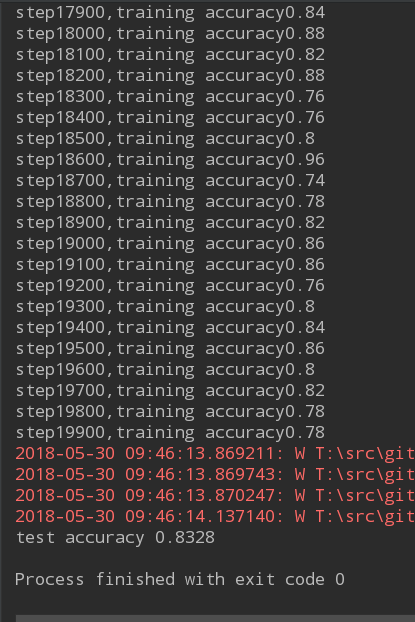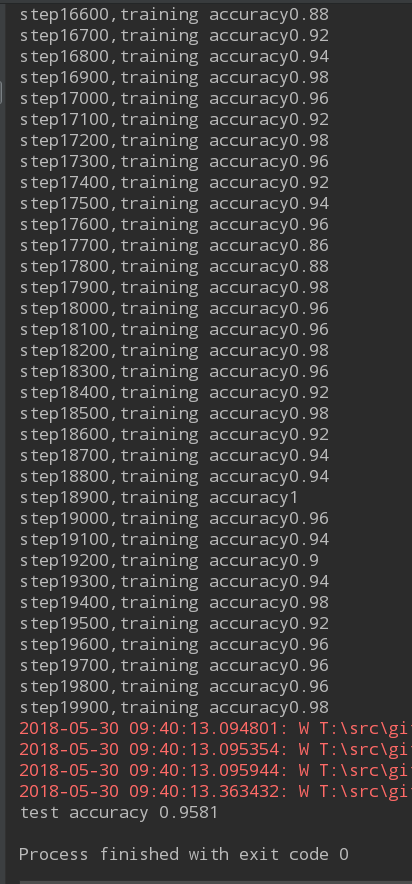本次试验一共两层网络,比较简单,在实验中发现,将学习率设为1e-4时,测试精度为23.7%,将学习率设为1e-3时,测试精度为83.28%,将学习率设置为1e-2时,测试精度为95.81%,随着学习率的增大虽然测试精度提高了,但是在训练过程中发现当学习率为0.01时出现了了梯度爆炸现象。 一般2层的话学习率在设置0.001-0.005之间 , 如果10层可以设置到0.01
代码:
import tensorflow as tf
from tensorflow.examples.tutorials.mnist import input_data
#读入数据
mnist=input_data.read_data_sets("MNIST_data/",one_hot=True)
#定义训练集数据的占位符
#x为训练图像的占位符,y_为训练图像标签的占位符
x=tf.placeholder(tf.float32,[None,784])
y_=tf.placeholder(tf.float32,[None ,10])
#将单张图片从784维向量还原为28*28的矩阵图片
x_image=tf.reshape(x,[-1,28,28,1])
#对训练图像进行卷积运算
def weight_variable(shape):
initial=tf.truncated_normal(shape,stddev=0.1)
return tf.Variable(initial)
def bias_variable(shape):
initial=tf.constant(0.1,shape=shape)
return tf.Variable(initial)
def conv2d(x,W):
return tf.nn.conv2d(x,W,strides=[1,1,1,1],padding='SAME')
def max_pool_2x2(x):
return tf.nn.max_pool(x,ksize=[1,2,2,1],strides=[1,2,2,1],padding='SAME')
#第一层卷积层
W_conv1=weight_variable([5,5,1,32])
b_conv1=bias_variable([32])
h_conv1=tf.nn.relu(conv2d(x_image,W_conv1)+b_conv1)
h_pool1=max_pool_2x2(h_conv1)
#第二层卷积层
W_conv2=weight_variable([5,5,32,64])
b_conv2=bias_variable([64])
h_conv2=tf.nn.relu(conv2d(h_pool1,W_conv2)+b_conv2)
h_pool2=max_pool_2x2(h_conv2)
#全连接层,输出为1024维的向量
W_fc1=weight_variable([7*7*64,1024])
b_fc1=bias_variable([1024])
h_pool2_flat=tf.reshape(h_pool2 ,[-1,7*7*64])
h_fc1=tf.nn.relu(tf.matmul(h_pool2_flat,W_fc1)+b_fc1)
#使用Dropout,keep_prob是一个占位符,训练时为0.5,测试时为1
keep_prob=tf.placeholder(tf.float32)
h_fc1_drop=tf.nn.dropout(h_fc1,keep_prob)
#把1024维的向量转换成10维,对应为10类
W_fc2=weight_variable([1024,10])
b_fc2=bias_variable([10])
y_conv=tf.matmul(h_fc1_drop,W_fc2)+b_fc2
#采用tf.nn.softmax_cross_entropy_with_logits计算
cross_entropy=tf.reduce_mean(
tf.nn.softmax_cross_entropy_with_logits(labels=y_,logits=y_conv))
#同样定义train_step
train_step=tf.train.AdadeltaOptimizer(1e-2).minimize(cross_entropy)
#定义测试的准确率
correct_prediction=tf.equal(tf.argmax(y_conv,1),tf.argmax(y_,1))
accuracy=tf.reduce_mean(tf.cast(correct_prediction,tf.float32))
#创建Session,对变量初始化
sess=tf.InteractiveSession()
sess.run(tf.global_variables_initializer ())
#训练20000步
for i in range (20000):
batch=mnist.train.next_batch(50)
#每100步报告一次在验证集上的准确率
if i%100==0:
train_accuracy=accuracy.eval(feed_dict={
x:batch[0],y_:batch[1],keep_prob:1.0 })
print("step%d,training accuracy%g"%(i,train_accuracy))
train_step.run(feed_dict={x:batch[0],y_:batch[1],keep_prob:0.5})
#训练结束后报告在测试集上的准确率
print("test accuracy %g" %accuracy.eval(feed_dict={
x:mnist.test.images,y_:mnist.test.labels,keep_prob:1.0}))
学习率为0.001时的结果
学习率为0.01时的结果
读者朋友发现有什么不对的地方欢迎留言说明~~

